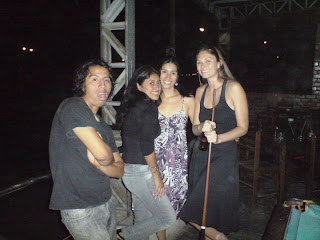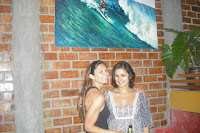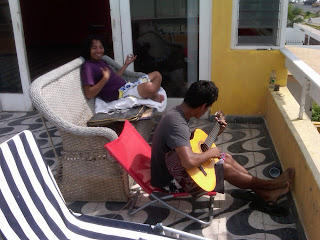If you are interested in supporting this great organization and learning more about Elmer´s story, you can visit:
http://www.fairmail.info/photographers/profile/elmer
Since I am shamelessly promoting my students in this blog, let me tell you about the other organization that Espaanglisch partners with here in Trujillo. Rodolfo, who joined my English class a few weeks ago, and David work with a group called SKIP (Supporting Kids in Peru), which educates children in some of the same areas where we teach for USDA. If you want to read a bit more about SKIP and the work they are doing, their website is below:
http://www.skipperu.org/index.php
Finally, if you want to contribute to USDA or Espaanglisch, either by coming to Peru to volunteer or donating to their current projects, please let me know, and I will put you in touch with the appropriate people. There is information about charitable donations at USDA.org (link below) and Espaanglisch is currently working on an online giving site.
http://www.usdaperu.org/en/donations
I didn´t have any big adventures over the past week, but there were many good times had in and around Trujillo. Last Monday, after returning from Huaraz on the overnight bus, Tia Carmen treated my fellow volunteers and I to a homemade lunch in honor of my birthday. The festivities continued into Tuesday at Maria´s house in Huanchaco with a delicious seafood feast for me and my new pals. After dinner, we all headed to a bar down the street for pool, Jenga, and general merriment. I was overwhelmed and happy by the turnout at my belated birthday party; I feel so lucky to have made such great friends in the short time I´ve been in Peru.
With the slightest twinge of a hangover hovering over the group, we headed out to sweltering Uno A the next morning. I don´t know about the rest of you, but for me, nothing cures a headache and an acidic stomach like an overly complicated craft project with young children! Please see pictures below:
Since our trip up to Huaraz, Ruwan had been complaining about a sore on his leg that seemed to be getting worse by the day. Anjana and I, being the good moms that we are, forced him to go to the clinic to have it checked out after our classes finished. Later that afternoon, poor Ru came home from the hospital with bad news. Apparently a small insect bite had turned into a massive infection and the doctor had to perform minor surgery to clean out the sore. Since then, Ru has been on bed rest and is slowly getting better.
With Ru out of commission, Anjana and I spent Thursday afternoon taking in the sites of downtown Trujillo. We tried to visit the VERY creepy Museo del Juegete (Toy Museum), but it was closed. Good thing, because we peeked inside the window and it was filled with the kind of carnival figurines and old-fashioned baby dolls that still give me nightmares.
After, we ate at a beautiful cafe called Cadona Deza, which, according to the owner, was the former mansion of a Spanish sea captain. The center of Trujillo is filled with colonial style homes and social clubs tucked away behind large wooden doors and wrought iron gates. If you ever visit, it is definitely worth checking out the hidden courtyards scattered around the Plaza de Armas...
....and the casinos named after popular American music-television programs from the 80s.
Following our big day on the town, I was faced with my biggest teaching challenge yet. My Thursday night class has grown to approximately 12 students, many of whom have never spoken a word of English in their lives. For those students who have been coming for a few weeks, this was a bit of a blow because I had to backtrack about 5 chapters in our book and re-teach very rudimentary words and phrases. I´m hoping that we will be able to split the class into two groups this week, but since Ru is still convalescing and Anjana is out of town for a few days, I´m going to have to improvise for now.
I spent Friday in Huanchaco with Anjana. The day started out on a pretty uneventful note and after some beach time, she and I headed to one of the local watering holes for an afternoon cocktail. On our way down a quiet back street, a taxi drove by us, stopped about 100 yards down the road, turned around and parked along the sidewalk. As Anjana and I approached, we called out to us, ¨Hola, chicas!¨. I turned my head to nod politely and saw, to my horror, that the pervert had his shirt pulled up, his pants down around ankles and was proudly displaying his man parts. It was, officially, my first run-in with a Peruvian flasher.
As I attempted to rid the aforementioned scene from my head, Anjana and I returned to Trujillo for Compartidos, which was taking place by the Plaza de Armas. That night, USDA helped about 20 kids make hand painted pencil cases for school and fed about 50 people around the square. I was a bit irritated that night because there were several men who came for a free meal who clearly were not in need. We had to turn down about 5 kids at the end of the night because we ran out of food. Later that evening, when I was out with some of the other volunteers, I spotted one of said men across the bar, happily drinking with his friends. I REALLY wanted to give him a piece of my mind, but I restrained myself.
The rest of Friday night was a blast. Anjana and I met up with Teresa and Pedro, two Peruvian USDA volunteers, and we headed to a boisterous bar with live music. A four-person dance party broke out on the balcony, much to the bewilderment of the other patrons, and we kept the fiesta going until the wee hours of the morning (photos to follow). Saturday and Sunday were spent on the beach, enjoying the nice weather and the company of friends.
Caballitos de Tortoras in Huanchaco
View of the Beach
Oh, and on my latest trip to the mall, I spotted this very familiar looking logo for GCI Peru! Who knew? And it´s a general contracting company to boot!

























 View from the lawn
View from the lawn












